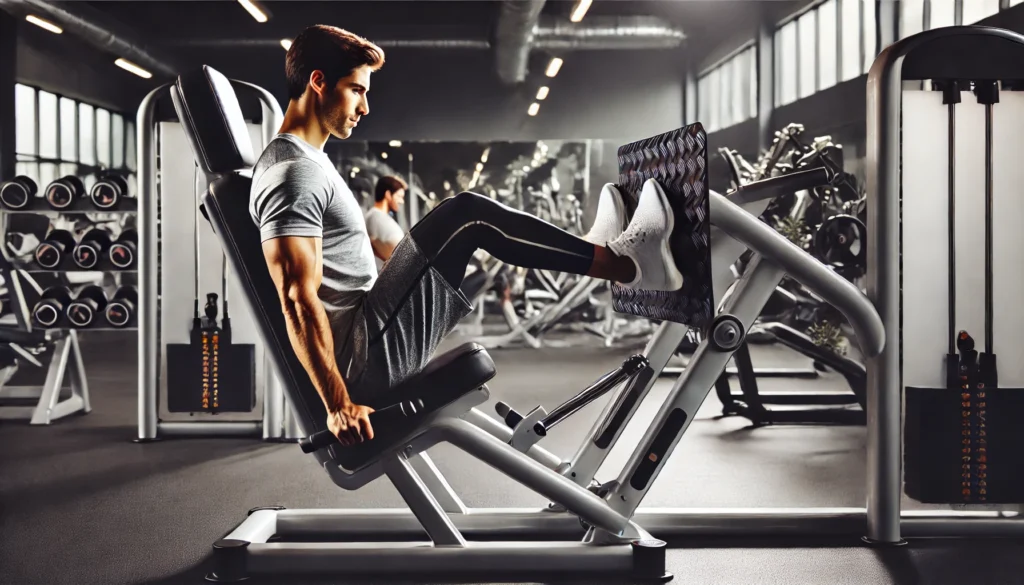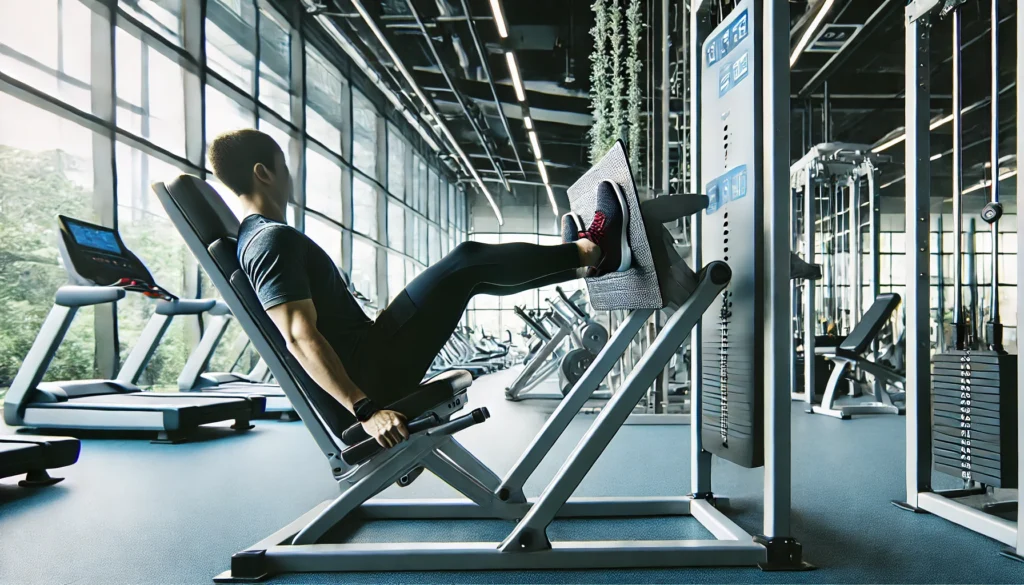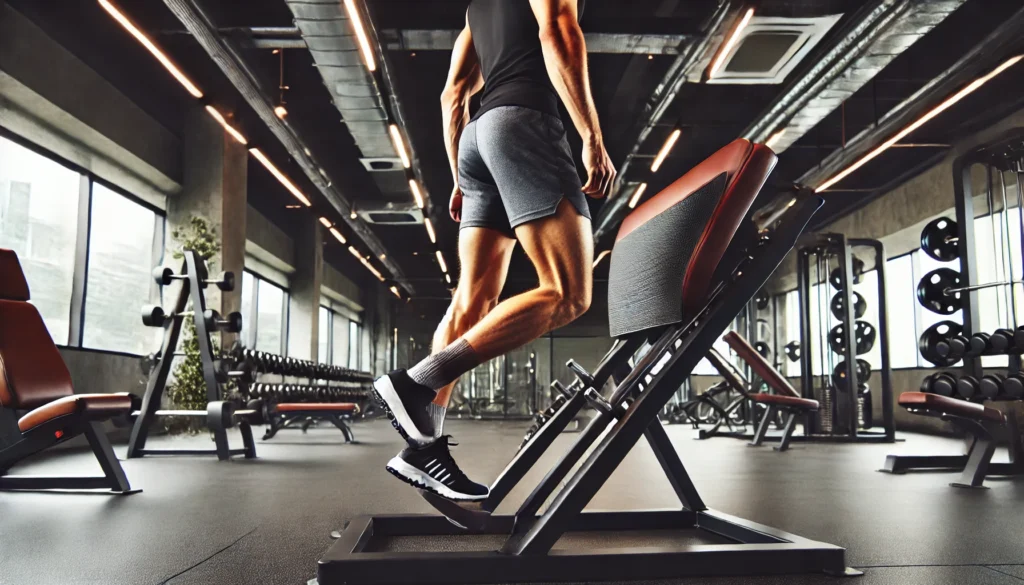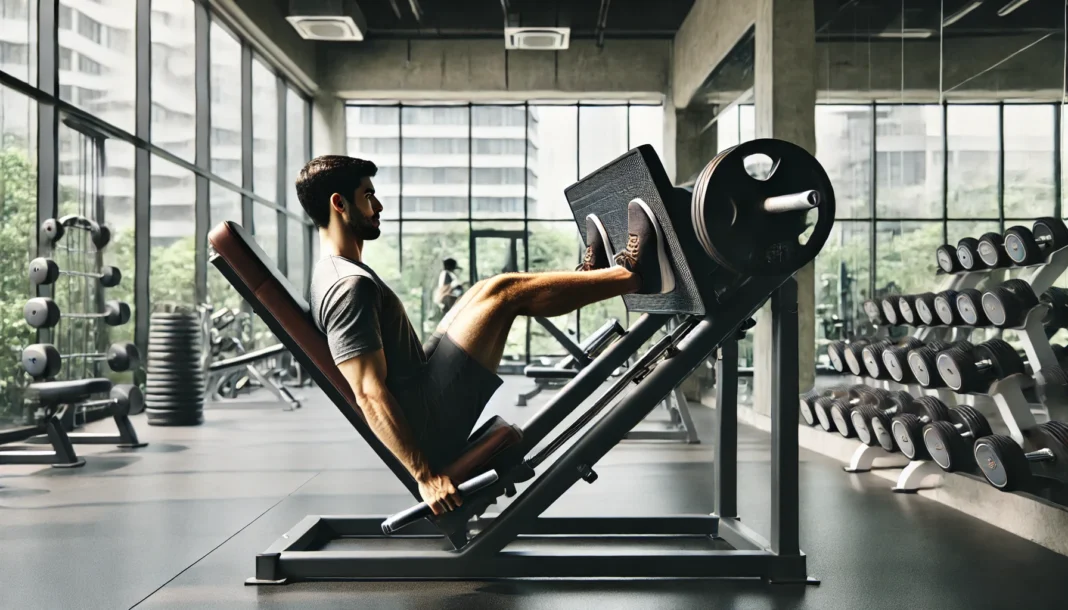Introduction: The Power of Machine-Based Lower Body Training
Leg machine exercises provide a controlled and efficient way to build lower body strength, enhance muscle definition, and improve overall athletic performance. Unlike free weights, machines offer guided movement patterns that reduce the risk of injury while allowing lifters to focus on muscle engagement. Whether you are a beginner seeking stability or an advanced athlete aiming for hypertrophy, a lower body workout with machines can be customized to suit various fitness levels. With consistent training, leg machines help improve muscular endurance, correct imbalances, and enhance overall movement efficiency. Understanding the benefits and execution of these exercises is essential for optimizing training outcomes and achieving fitness goals.
You may also like: The Ultimate Bodyweight Workout Routine for Full-Body Strength and Performance
The Science Behind Leg Machine Training
The biomechanical advantages of leg machine exercises make them highly effective for lower body development. Machines provide a fixed range of motion, ensuring that muscles are activated in a controlled and efficient manner. This eliminates excessive strain on stabilizer muscles, allowing lifters to focus solely on targeted muscle engagement. Additionally, machines facilitate progressive overload by enabling consistent resistance adjustments, which is essential for muscle hypertrophy and strength gains. A lower body workout with machines enhances neuromuscular coordination, promoting proper movement mechanics and reducing injury risks. By leveraging these benefits, individuals can train with higher intensity while maintaining joint integrity and structural balance.
Structuring an Effective Lower Body Workout with Machines
An optimal lower body workout with machines should include a combination of compound and isolation exercises to ensure balanced muscle development. Compound movements, such as the leg press and hack squat, engage multiple muscle groups simultaneously, maximizing efficiency and strength gains. Isolation exercises, such as the leg extension and seated calf raise, target specific muscles to enhance definition and address muscular imbalances. Proper sequencing, including warming up with lighter loads before progressing to heavier resistance, ensures optimal performance and injury prevention. Adjusting tempo, rep ranges, and rest periods allows for further customization based on individual training goals. With a strategic approach, machine-based leg workouts can yield significant improvements in strength, endurance, and muscular symmetry.
Key Leg Machine Exercises for Maximum Strength and Muscle Development
A well-rounded leg machine workout includes several fundamental movements that target key muscle groups. The leg press is an essential exercise that engages the quadriceps, hamstrings, and glutes, providing a safe alternative to barbell squats. Leg extensions effectively isolate the quadriceps, helping to enhance definition and strength in the front of the thigh. The seated leg curl targets the hamstrings, promoting posterior chain development and improving knee stability. The calf raise machine strengthens the gastrocnemius and soleus muscles, enhancing lower leg endurance and power. Incorporating these exercises into a lower body workout with machines ensures comprehensive muscle activation and balanced development.

The Role of Resistance and Rep Schemes in Leg Machine Training
To maximize results, it is important to adjust resistance levels and repetition schemes based on individual fitness goals. For muscle hypertrophy, performing 8-12 repetitions per set with moderate-to-heavy resistance is recommended. For strength development, lower rep ranges (4-6 reps) with heavier resistance encourage maximum force production. For muscular endurance, higher rep ranges (15-20 reps) with lighter weights improve stamina and metabolic efficiency. Periodization, or cycling through different rep schemes over time, ensures continuous progression and prevents training plateaus. Customizing resistance and rep schemes allows individuals to optimize their lower body workout with machines for specific performance outcomes.
Common Mistakes to Avoid When Performing Leg Machine Exercises
Despite their advantages, leg machine exercises must be performed with proper technique to avoid common pitfalls. One mistake is using excessive weight, which can compromise form and increase the risk of injury. Failing to adjust machine settings, such as seat positioning, can lead to inefficient movement patterns and discomfort. Neglecting full range of motion reduces muscle activation and limits strength gains. Relying solely on machines without incorporating functional movements may lead to imbalances and reduced athleticism. Being mindful of these factors ensures that a lower body workout with machines is both safe and effective.
The Benefits of Machine Training for Rehabilitation and Injury Prevention
Leg machine exercises are often utilized in rehabilitation settings due to their controlled movement patterns and reduced injury risk. Individuals recovering from knee, hip, or lower back injuries benefit from machine training as it provides support and stability. Strengthening muscles with machines helps improve joint function, reducing strain on ligaments and tendons. A lower body workout with machines is particularly beneficial for those with mobility limitations, as it allows them to build strength safely. Gradual progression with machine-based training facilitates recovery while minimizing re-injury risks, making it a valuable tool for long-term musculoskeletal health.
Integrating Machines with Free Weights for a Balanced Training Program
While leg machine exercises offer significant benefits, integrating them with free weights can create a well-rounded training regimen. Machines provide isolation and stability, while free weights enhance coordination and functional strength. For example, pairing leg press movements with barbell squats improves both stability and dynamic force production. Combining seated leg curls with Romanian deadlifts ensures balanced posterior chain development. By incorporating both training modalities, individuals can maximize lower body strength, muscle definition, and movement efficiency. A hybrid approach that includes machines and free weights is ideal for achieving comprehensive fitness goals.

Frequently Asked Questions (FAQ) on Leg Machine Exercises and Lower Body Workouts with Machines
1. How do leg machine exercises compare to free weight exercises for lower body strength?
Leg machine exercises provide controlled movement patterns that help individuals target specific muscle groups without requiring as much stabilization as free weights. This makes them ideal for beginners, individuals recovering from injuries, or those looking to isolate certain muscle groups. While free weights improve overall balance and coordination, a lower body workout with machines allows for greater load management and progressive overload without compromising form. Additionally, leg machines reduce the risk of improper technique, ensuring more consistent muscle activation. For a balanced approach, integrating both machine-based and free-weight exercises can optimize lower body strength and endurance.
2. What are the best leg machine exercises for building muscle mass?
For muscle hypertrophy, leg press, hack squat, and seated calf raises are highly effective machine-based exercises. The leg press engages the quadriceps, hamstrings, and glutes, allowing for heavy resistance training with reduced lower back strain. Hack squats target the quadriceps while maintaining spinal stability, making them an excellent alternative to traditional squats. Seated calf raises isolate the gastrocnemius and soleus muscles, contributing to lower leg development. Incorporating these exercises into a lower body workout with machines ensures comprehensive muscle engagement and growth.
3. How can leg machine exercises benefit individuals recovering from injuries?
Machines provide a safe and controlled environment for rehabilitation by limiting unwanted movement patterns and reducing joint stress. Exercises such as the seated leg curl and leg extension allow individuals to strengthen specific muscles without engaging the stabilizers excessively, which can be beneficial for those recovering from knee injuries. The leg press, when performed with proper foot positioning, can help rebuild strength without putting undue strain on the lower back. Additionally, a lower body workout with machines enables gradual resistance adjustments, allowing for progressive recovery. Working with a physical therapist or trainer can further optimize machine-based rehabilitation programs.
4. What is the ideal rep and set range for leg machine exercises to improve endurance?
To enhance muscular endurance, performing higher repetitions (15-20 per set) with moderate resistance is recommended. This approach ensures sustained muscle engagement while minimizing fatigue-related injury risks. Exercises like the leg extension and seated calf raise can be performed in endurance-based rep ranges to build stamina. A lower body workout with machines should also incorporate controlled tempo repetitions to maximize time under tension. Additionally, reducing rest intervals between sets can further promote muscular endurance and metabolic conditioning.
5. How does adjusting foot placement impact muscle activation during leg press exercises?
Foot positioning on the leg press significantly influences muscle recruitment. Placing the feet higher on the platform emphasizes the hamstrings and glutes, whereas a lower placement shifts more focus onto the quadriceps. A wider stance engages the inner thigh muscles (adductors), while a narrower stance targets the outer quadriceps. For balanced muscle development, incorporating various foot positions in a lower body workout with machines can enhance overall strength and coordination. Understanding these adjustments allows individuals to tailor their training to specific muscle groups and fitness goals.
6. Can a lower body workout with machines help improve athletic performance?
Yes, leg machine exercises enhance lower body strength, power, and endurance, all of which contribute to improved athletic performance. Movements like the hack squat and leg press develop explosive power, benefiting sprinters and jump-based athletes. Strengthening the hamstrings and calves using machines like the seated leg curl and standing calf raise improves running mechanics and stability. Machine-based training also allows athletes to focus on unilateral work, reducing muscular imbalances that could impact movement efficiency. When combined with functional training, machine-based workouts can enhance sport-specific performance and injury resilience.
7. Are leg machine exercises effective for fat loss?
A lower body workout with machines can contribute to fat loss by increasing overall muscle mass, which in turn boosts metabolic rate. Compound movements like the leg press and hack squat recruit large muscle groups, leading to higher calorie expenditure. Implementing supersets and short rest intervals can further elevate heart rate and promote fat oxidation. Machines allow individuals to train at higher intensities with controlled movement patterns, making them ideal for circuit-style fat-burning workouts. Combining strength training with cardiovascular exercise maximizes fat loss while preserving lean muscle.
8. How can beginners get started with a lower body workout using machines?
Beginners should start with fundamental exercises like leg press, leg extensions, and seated leg curls to build strength and confidence. Using lighter resistance and focusing on controlled movement patterns helps develop proper technique and prevents injury. Gradually increasing resistance and volume ensures continuous progress without overwhelming the muscles. A well-structured lower body workout with machines should also incorporate sufficient rest periods to allow for muscle adaptation. Seeking guidance from a fitness professional can help beginners create a balanced and effective machine-based training plan.
9. What are the benefits of incorporating unilateral leg machine exercises?
Unilateral exercises, such as single-leg leg press or single-leg extensions, help correct muscle imbalances and improve coordination. Training one leg at a time ensures both sides of the body develop strength symmetrically, reducing the risk of injuries caused by compensatory movement patterns. Unilateral leg machine exercises enhance balance and core stability by forcing the body to engage stabilizing muscles. Athletes and individuals recovering from injuries can particularly benefit from this training approach. Incorporating unilateral work into a lower body workout with machines ensures comprehensive strength development and injury prevention.
10. How often should leg machine exercises be performed for optimal results?
Training frequency depends on individual goals, but generally, two to three lower body sessions per week yield optimal results. For muscle growth, incorporating leg machine exercises with adequate recovery time ensures progressive overload and adaptation. Athletes focusing on endurance may train lower body muscles more frequently using moderate resistance and higher repetitions. Those prioritizing fat loss can integrate machine-based leg exercises into circuit training to maximize calorie burn. Structuring a lower body workout with machines based on personal fitness objectives helps maintain consistency and long-term progress.

Conclusion: Optimizing Leg Machine Workouts for Long-Term Success
A strategic approach to leg machine training can significantly enhance lower body strength, muscle growth, and overall athletic performance. By understanding the benefits of leg machine exercises and executing them with proper form, individuals can optimize their training outcomes. Incorporating compound and isolation movements, adjusting resistance levels, and integrating machines with free weights ensures a well-balanced workout. With consistency and progressive overload, a lower body workout with machines can lead to substantial improvements in strength, endurance, and muscular definition. Whether for rehabilitation, hypertrophy, or general fitness, machine-based leg training remains a powerful tool for lower body development.
strength training, muscle hypertrophy, resistance training, leg day workout, gym machines, progressive overload, lower body strength, injury prevention, functional training, muscle definition, weight training techniques, athletic performance, rehabilitation exercises, machine-based workouts, strength conditioning, gym programming, exercise biomechanics, fitness progression, controlled resistance, performance enhancement.
Further Reading:
10 Best Gym Machines To Build Bigger Legs (With Workouts)
12 Best Smith Machine Leg Exercises (With Workout Routines)
Top Leg Machine Workouts for Building Stronger Lower Body Strength
Important Note: The content provided by HealthXWire is for informational purposes only and should not be construed as medical advice, diagnosis, or treatment. While we strive for accuracy, the information presented on this site may not reflect the most current research or medical guidelines. Always seek the advice of your physician or other qualified health provider with any questions you may have regarding a medical condition. HealthXWire does not endorse, recommend, or guarantee the efficacy of any products, services, or treatments mentioned on this site. Users should not disregard professional medical advice or delay seeking it because of something they have read on HealthXWire. HealthXWire is not liable for any damages, loss, or injury arising from reliance on the information provided herein.



